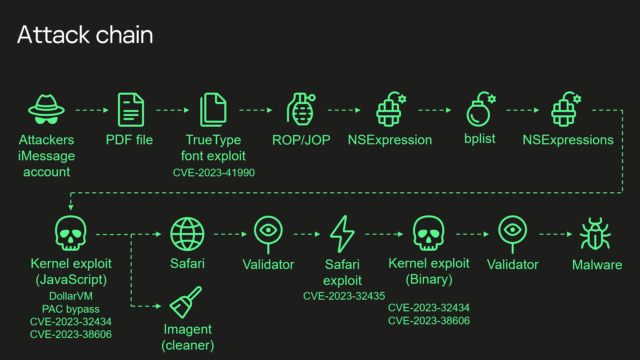Operation Triangulation: 4-Year Campaign That Backdoored iPhones
"Researchers on Wednesday presented intriguing new findings surrounding an attack that over four years backdoored dozens if not thousands of iPhones."

- "Chief among the discoveries: the unknown attackers were able to achieve an unprecedented level of access by exploiting a vulnerability in an undocumented hardware feature that few if anyone outside of Apple and chip suppliers such as ARM Holdings knew of."
“Our analysis hasn't revealed how they became aware of this feature, but we're exploring all possibilities, including accidental disclosure in past firmware or source code releases. They may also have stumbled upon it through hardware reverse engineering,” said Kaspersky researcher Boris Larin.
- "A fresh infusion of details disclosed Wednesday said that “Triangulation” exploited four critical zero-day vulnerabilities which are tracked as CVE-2023-32434, CVE-2023-32435, CVE-2023-38606 and CVE-2023-41990."
- "Besides affecting iPhones, these critical zero-days and the secret hardware function resided in Macs, iPods, iPads, Apple TVs, and Apple Watches. What’s more, the exploits Kaspersky recovered were intentionally developed to work on those devices as well."
“This is no ordinary vulnerability. Due to the closed nature of the iOS ecosystem, the discovery process was both challenging and time-consuming, requiring a comprehensive understanding of both hardware and software architectures. What this discovery teaches us once again is that even advanced hardware-based protections can be rendered ineffective in the face of a sophisticated attacker, particularly when there are hardware features allowing to bypass these protections,” Larin said for press.
- "If we try to describe this feature and how attackers use it, it all comes down to this: attackers are able to write the desired data to the desired physical address with [the] bypass of [a] hardware-based memory protection by writing the data, destination address and hash of data to unknown, not used by the firmware, hardware registers of the chip."
- "Our guess is that this unknown hardware feature was most likely intended to be used for debugging or testing purposes by Apple engineers or the factory, or was included by mistake. Since this feature is not used by the firmware, we have no idea how attackers would know how to use it."





